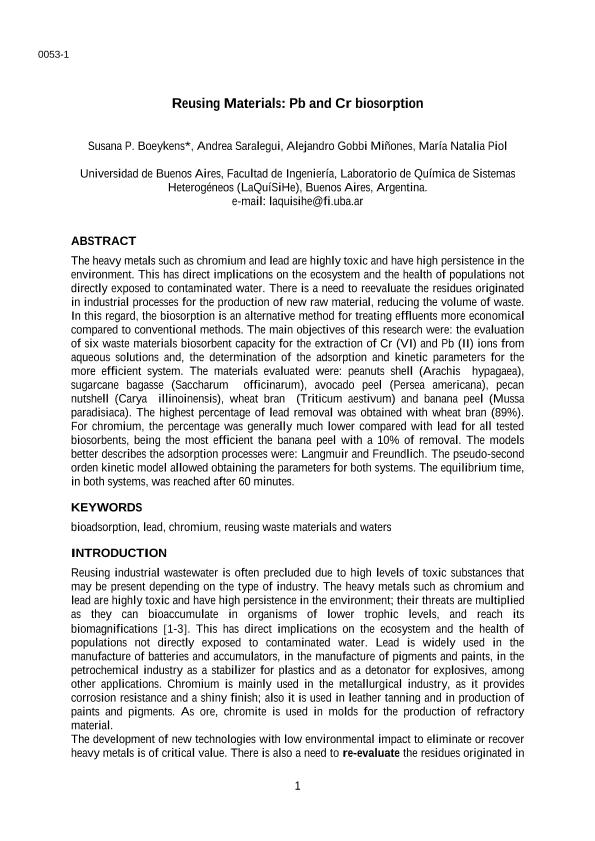Artículo
Reusing Materials: Pb and Cr biosorption
Boeykens, Susana Patricia; Saralegui, Andrea Beatriz; Gobbi Miñones, Alejandro Ricardo; Piol, María Natalia

Fecha de publicación:
09/2016
Editorial:
University of Zagreb
Revista:
CD Proceedings
ISSN:
1847-7178
Idioma:
Inglés
Tipo de recurso:
Artículo publicado
Clasificación temática:
Resumen
The heavy metals such as chromium and lead are highly toxic and have high persistence in the environment. This has direct implications on the ecosystem and the health of populations not directly exposed to contaminated water. There is a need to reevaluate the residues originated in industrial processes for the production of new raw material, reducing the volume of waste. In this regard, the biosorption is an alternative method for treating effluents more economical compared to conventional methods. The main objectives of this research were: the evaluation of six waste materials biosorbent capacity for the extraction of Cr (VI) and Pb (II) ions from aqueous solutions and, the determination of the adsorption and kinetic parameters for the more efficient system. The materials evaluated were: peanuts shell (Arachis hypagaea), sugarcane bagasse (Saccharum officinarum), avocado peel (Persea americana), pecan nutshell (Carya illinoinensis), wheat bran (Triticum aestivum) and banana peel (Mussa paradisiaca). The highest percentage of lead removal was obtained with wheat bran (89%). For chromium, the percentage was generally much lower compared with lead for all tested biosorbents, being the most efficient the banana peel with a 10% of removal. The models better describes the adsorption processes were: Langmuir and Freundlich. The pseudo-second orden kinetic model allowed obtaining the parameters for both systems. The equilibrium time, in both systems, was reached after 60 minutes.
Palabras clave:
REUSING
,
HEAVY METALS
,
LOW COST
,
ADSORPTION
Archivos asociados
Licencia
Identificadores
Colecciones
Articulos(SEDE CENTRAL)
Articulos de SEDE CENTRAL
Articulos de SEDE CENTRAL
Citación
Boeykens, Susana Patricia; Saralegui, Andrea Beatriz; Gobbi Miñones, Alejandro Ricardo; Piol, María Natalia; Reusing Materials: Pb and Cr biosorption; University of Zagreb; CD Proceedings; 9-2016; 1-6
Compartir



